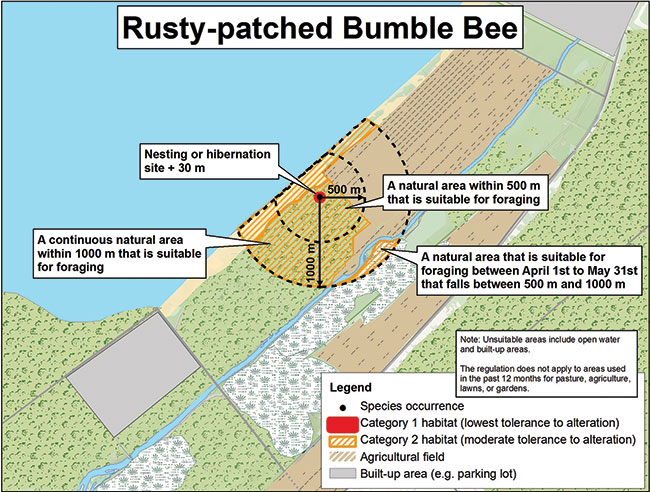Rusty-patched Bumble Bee Habitat Protection Summary
This document provides a brief description of the area that is protected as habitat for the Rusty-patched Bumble Bee through a habitat regulation under the Endangered Species Act.
The Rusty-patched Bumble Bee is a medium to large-sized bumble bee with a distinctive rusty-coloured patch on its abdomen. It depends on a wide variety of habitats with flowering plants and woody debris available. The Rusty-patched Bumble Bee was one of the most common species of bumble bee in southern Ontario until the 1980s. It was assessed by the Committee on the Status of Species at Risk in Ontario (COSSARO) and listed as endangered on September 28, 2010 due to its dramatic population decline.
The habitat regulation for the Rusty-patched Bumble Bee protects
- any nesting or hibernation site and the surrounding 30 metre area;
- natural areas within 500 metres of a Rusty-patched Bumble Bee that provide suitable foraging conditions. Areas suitable for foraging include prairie, savannah, woodland, marsh, bog, forest, sand dune, old field or similar areas;
- if any of these natural areas extend beyond 500 metres, those areas are protected for up to an additional 500 metres;
- natural areas that provide suitable foraging conditions for a Rusty-patched Bumble Bee between April 1st to May 31st that fall between 500 metres and 1000 metres of a Rusty-patched Bumble Bee;
- these areas are protected until five consecutive years of documented non-use.
Areas that are considered unsuitable habitat for the Rusty-patch Bumble Bee include open water and built-up areas such as roads and parking lots. The regulation does not apply to an area that was used in the past 12 months for pasture, growing, producing or raising farm animals, producing agricultural crops, or growing a garden or lawn.
The regulation applies where the species occurs south of 45°30'0" north latitude, which is the area approximately south of Algonquin Park. As of December 2012, the only recent confirmed locations for the Rusty-patched Bumble Bee are two sites within The Pinery Provincial Park.
Supporting rationale
- A distance of 30 metres around a nesting or hibernation site is intended to protect the feature itself and the terrestrial area required to maintain the suitability of the site.
- Bumble bees prefer to forage in areas that contain abundant food sources. They are more likely to visit areas that are close to their nest colony, but have been known to travel longer distances to access high quality sites. Distances of 500 metres and 1000 meters represent typical flight ranges found in studies on bumble bees.
- The Rusty-patched Bumble Bee is very susceptible to habitat fragmentation. Protection of large areas of connected, suitable habitat enables movement, maintenance of genetic diversity, and minimization of herbicide and pesticide exposure.
- Food sources that are available during the spring (e.g. April 1st to May 31st) are limited but critical to the initial colony development phase of the Rusty-patched Bumble Bee, when queens emerge from overwintering sites to forage, build up resources, and establish new nests.
- A five-year term allows sufficient time to determine that the site is no longer being used.
Activities in Rusty-patched Bumble Bee habitat
Activities in regulated habitat can continue as long as the function of these areas is maintained and individuals of the species are not killed, harmed, or harassed.
Generally compatible:
- Activities that help to maintain semi-open or open habitats which provide an abundance of food resources (flowering plants).
- Use of existing recreational trails.
- Continuation of most existing maintenance practices, such as pruning of shrubs or trees, or removal of an individual shrub or tree.
Generally not compatiblefootnote 1 :
- Broad-scale application of herbicides or pesticides (particularly neonicotonids) within or near regulated habitat, including areas where drift into regulated habitat may occur.
- Significant removal or reduction of flowering plants, woody debris, and any documented nesting or hibernation sites.
- Large-scale construction, such as housing development or roads.
Key terms
- Hibernation site: A feature that provides insulation from extreme cold temperatures during the winter. For the Rusty-patched Bumble Bee, some examples include small mammal burrows and rotting logs.
- Neonicotonids: A group of neuro-active, synthetic chemical insecticides that are similar to nicotine and were developed in the past several decades.
Below you will find an example diagram of how this regulation would be applied to protect habitat for this species. It indicates how the protected habitat has been categorized, based on how the species uses the habitat and how much activity or change can occur within the habitat, as per the policy "Categorizing and Protecting Habitat Under the Endangered Species Act".
Sample application of the Habitat Regulation

Enlarge sample application of the Habitat Regulation
The content of this summary is provided for convenience only. For accurate reference and the most recent version of the regulation, please view Ontario Regulation 832/21 on e-Laws
Footnotes
- footnote[1] Back to paragraph If you are considering an activity that may not be compatible with regulated habitat, please contact your local MNR office for more information and/or to discuss ESA authorization options.